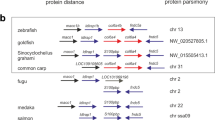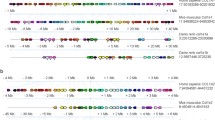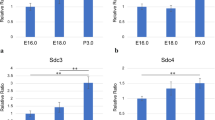Abstract
Collagen V is a quantitatively minor component of collagen I fibrils and the defective product of classic Ehlers-Danlos syndrome (EDS). To provide new insights into its embryonic function, a continuous evaluation of the expression pattern of proα1(V), a chain common to all collagen V molecular forms, was performed by in situ hybridization of developing mouse from 7.5 days after conception (dpc) to birth. Proα1(V) transcripts were first detected at 8.5 dpc, signals being considerably augmented at 16.5 dpc and declining at birth. Hybridization signals were, at first, exclusively detected in the dorsal aorta wall, heart, and adnexa. At 10.5 dpc, col5a1 expression was found in the heart, dorsal aorta wall, branchial arches, mesonephrotic tubules, and intestinal mesenchyme and coincided with proα1(I) developmental expression. Later stages exhibited an intense signal in more restricted regions, notably the skin, the bones and vertebral column, the cornea, the tendons and ligaments, the peritoneal membranes, the umbilical cord, and the salivary gland. The data revealed the important contribution of collagen V to the development of functional connective tissues. Proα1(V) signals were exclusively detected in the flattened cells of the surface ectoderm at 10.5 dpc. By 12.5 dpc, when cells had become cuboidal, the signal switched to the dermal fibroblasts. Thus, type V collagen appears to contribute to epidermis differentiation. Our data also suggest that collagen V participates in bone formation and/or mineralization and in the renewal of stromal cells in the cornea. The results underscore the role of collagen V in developing embryos and provide important clues for analyzing the phenotype of mouse models for EDS.






Similar content being viewed by others
References
Adachi E, Hopkinson I, Hayashi T (1997) Basement-membrane stromal relationships: interactions between collagen fibrils and the lamina densa. Int Rev Cytol 173:73–156
Andrikopoulos K, Suzuki HR, Solursh M, Ramirez F (1992) Localization of proα2(V) collagen transcripts in the tissues of the developing mouse embryo. Dev Dyn 195:113–120
Andrikopoulos K, Liu X, Keene DR, Jaenisch R, Ramirez F (1995) Targeted mutation in the col5a2 gene reveals a regulatory role for type V for type V collagen during matrix assembly. Nat Genet 9:31–36
Bonaventure J, Zylberberg L, Cohen-Sola L, Allain JC, Lassin C, Maroteaux P (1989) A new lethal brittle bone syndrome with increased amount of type V collagen in a patient. Am J Med Gen 33:299–310
Burrows NP, Nicholls AC, Yates JR, Gatward G, Sarathachandra P, Richards A, Pope FM (1996) The gene encoding collagen alpha1(V) (COL5A1) is linked to mixed Ehlers-Danlos syndrome type I/II. J Invest Dermatol 106:1273–1276
Chanut-Delalande H, Fichard A, Bernocco S, Garrone R, Hulmes D, Ruggiero F (2001) Control of heterotypic fibril formation by collagen V is determined by chain stoichiometry. J Biol Chem 276:24352–24359
Chanut-Delalande H, Bonod-Bidaud C, Cogne S, Malbouyres M, Ramirez F, Fichard A, Ruggiero F (2004) Development of a functional skin matrix requires deposition of collagen V heterotrimers. Mol Cell Biol 24:6049–6057
Chernousov MA, Rothblum K, Tyler WA, Stahl RC, Carey DJ (2000) Schwann cells synthesize type V collagen that contains a novel α4 chain. Molecular cloning, biochemical characterization, and high affinity heparin binding of α4(V) collagen. J Biol Chem 275:28208–28215
Chu ML, Myers JC, Bernard MP, Ding JF, Ramirez F (1982) Cloning and characterization of five overlapping cDNAs specific for the human proα1(I) collagen chain. Nucl Acid Res 10:5925–5934
Fichard A, Kleman JP, Ruggiero F (1995) Another look at collagen V and XI molecules. Matrix Biol 14:515–531
Franc S, Rousseau JC, Garrone R, Rest M van der, Moradi-Ameli M (1998) Microfibrillar composition of umbilical cord matrix: characterization of fibrillin, collagen VI and intact collagen V. Placenta 19:95–104
Gordon MK, Foley JW, Birk DE, Fitch JM, Linsenmayer TF (1994) Type V collagen and Bowman's membrane. Quantitation of mRNA in corneal epithelium and stroma. J Biol Chem 269:24959–24966
Imamura Y, Scott IC, Greenspan DS (2000) The pro-alpha3(V) collagen chain. Complete primary structure, expression domains in adult and developing tissues, and comparison to the structures and expression domains of the other types V and XI procollagen chains. J Biol Chem 275:8749–8759
Kahai S, Vary CP, Gao Y, Seth A (2004) Collagen, type V, alpha1 (COL5A1) is regulated by TGF-beta in osteoblasts. Matrix Biol 23:445–455
Le Guellec D, Mallein Gerin F, Treilleux I, Bonaventure J, Peysson P, Herbage D (1994) Localization of the expression of type I, II and III collagen genes in human normal and hypochondrogenesis cartilage canals. Histochem J 26:695–704
Linsenmayer TF, Gibney E, Igoe F, Gordon MK, Fitch JM, Fessler LI, Birk DE (1993) Type V collagen: molecular structure and fibrillar organization of the chicken α1(V) NH2 terminal domain, a putative regulator of corneal fibrillogenesis. J Cell Biol 121:1181–1189
Linsenmayer TF, Igoe F, Gibney E, Gordon MK, Birk DE (1996) Positive regulation of corneal type V collagen mRNA: analysis by chicken-human heterokaryon formation. Exp Cell Res 228:36–43
Linsenmayer TF, Fitch JM, Gordon MK, Cai CX, Igoe F, Marchant JK, Birk DE (1998) Development and roles of collagenous matrices in the embryonic avian cornea. Prog Retin Eye Res 17:231–265
Malfait F, Coucke P, Symoens S, Loeys B, Nuytinck L, De Paepe A (2005) The molecular basis of classic Ehlers-Danlos syndrome: a comprehensive study of biochemical and molecular findings in 48 unrelated patients. Hum Mutat 25:28–37
Mao JR, Bristow J (2001) The Ehlers-Danlos syndrome: on beyond collagens. J Clin Invest 107:1063–1069
Mattei MG, Bruce B, Karsenty G (1993) Mouse α1 type V collagen gene maps to the (A2-B) region of chromosome 2. Genomic 16:786–788
McLaughlin JS, Linsenmayer TF, Birk DE (1989) Type V collagen synthesis and deposition by chicken embryo corneal fibroblasts in vitro. J Cell Sci 94:371–379
Metsäranta M, Toman D, De Crombrugghe B, Vuorio E (1991) Specific hybridization probes for mouse type I, II, III and IX collagen mRNAs. Biochim Biophys Acta 1089:241–243
Nicholls AC, Oliver JE, McCarron S, Harrison JB, Greenspan DS, Pope FM (1996) An exon skipping mutation of a type V collagen gene (COL5A1) in Ehlers-Danlos syndrome. J Med Genet 33:940–946
Niyibizi C, Eyre D (1994) Structural characteristics of cross-linking sites in type V collagen of bone chain specificities and heterotypic links of type I collagen. Eur J Biochem 224:943–950
Parekh TV, Wang XW, Makri-Werzen DM, Greenspan DS, Newman MJ (1998) Type V collagen is an epithelial cell cycle inhibitor that is induced by and mimics the effects of transforming growth factor beta1. Cell Growth Differ 9:423–433
Ricard-Blum S, Ruggiero F, Rest M van der (2005) The collagen superfamily. Curr Topics Chem 247:7–33
Ruggiero F, Comte J, Cabanas C, Garrone R (1996) Structural requirements for α1β1 and α2β1 integrin mediated cell adhesion to collagen V. J Cell Sci 109:1865–1874
Song J, Lee YG, Houston J, Petroll WM, Chakravarti S, Cavanagh HD, Jester JV (2003) Neonatal corneal stromal development in the normal and lumican-deficient mouse. Invest Ophthalmol Vis Sci 44:548–557
Stenn KS, Madri JA, Roll FJ (1979) Migrating epidermis produces AB2 collagen and requires continual collagen synthesis for movement. Nature 277:229–232
Wenstrup RJ, Florer JB, Brunskill EW, Bell SM, Chervoneva I, Birk DE (2004) Type V collagen controls the initiation of collagen fibril assembly. J Biol Chem 279:53331–53337
Wenstrup RJ, Florer JB, Davidson JM, Phillips CL, Pfeiffer BJ, Menezes DW, Chervoneva I, Birk DE (2006) Murine model of the Ehlers-Danlos syndrome: Col5a1 haploinsufficiency disrupts collagen fibril assembly at multiple stages. J Biol Chem 281:12888–12895
Yamaguchi K, Matsuo N, Sumiyoshi H, Fujimoto N, Iyama KI, Yanagisawa S, Yoshioka H (2005) Pro-alpha3(V) collagen chain is expressed in bone and its basic N-terminal peptide adheres to osteosarcoma. Matrix Biol 24:283–294
Acknowledgements
We are grateful to Catherine Souchier for her expertise in image analysis, to Pascale Peysson and Sylviane Guerret for technical assistance, and to Alain Bosch for art work.
Author information
Authors and Affiliations
Corresponding author
Additional information
This work was supported by the European Community (NMP2-CT-2003-504017) and by a grant from the GIS-Institut des Maladies Rares (A04115SP).
Rights and permissions
About this article
Cite this article
Roulet, M., Ruggiero, F., Karsenty, G. et al. A comprehensive study of the spatial and temporal expression of the col5a1 gene in mouse embryos: a clue for understanding collagen V function in developing connective tissues. Cell Tissue Res 327, 323–332 (2007). https://doi.org/10.1007/s00441-006-0294-1
Received:
Accepted:
Published:
Issue Date:
DOI: https://doi.org/10.1007/s00441-006-0294-1




